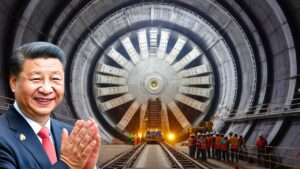How China Built the World’s Largest Underwater Tunnel in Just 110 Days.

In a feat that has stunned engineers around the world, China recently completed the world’s largest underwater tunnel — and did so in just 110 days. The project, located in the coastal province of Shandong, is being hailed as a modern marvel of engineering, showcasing China’s growing dominance in infrastructure innovation and rapid construction techniques.
The tunnel, part of the Taihu Tunnel project beneath Taihu Lake, spans over 10 kilometers and connects key economic zones across the Yangtze River Delta. What makes it especially remarkable is not just its size, but the blistering speed at which it was built — less than four months from start to finish.
So how did China achieve what most nations would consider impossible?
1. Pre-Fabrication at Scale
Much of the tunnel was constructed using prefabricated segments, manufactured off-site with precision and then transported and assembled on location. This modular approach dramatically cut down on time-consuming on-site work and ensured uniform quality. Using massive floating cranes, these segments were lowered and connected with near-perfect alignment under the water.
2. 24/7 Construction Schedules
Chinese engineers and construction teams worked around the clock in rotating shifts to keep progress continuous. Unlike traditional infrastructure projects that pause for weather or labor limits, this build pushed forward without delays, supported by thousands of workers and advanced robotic machinery.
3. Next-Level Technology and Automation
China leveraged AI-assisted tunneling equipment and automated machinery to handle excavation, alignment, and concrete placement. Real-time data monitoring allowed engineers to adjust and optimize every step of the build with pinpoint accuracy. These technologies reduced human error and improved efficiency exponentially.
4. Massive State Coordination
The tunnel project was backed by both provincial and central governments, allowing for streamlined permits, coordinated logistics, and uninterrupted funding. When a country aligns political will with engineering ambition, projects move faster — and this was a prime example.
The tunnel not only represents an engineering triumph but also a strategic infrastructure investment. It will slash travel times, boost regional trade, and strengthen connectivity in one of China’s most economically vital areas.
While skeptics question the long-term durability of such fast-paced construction, one thing is clear: China has redefined what’s possible in civil engineering. Building the world’s largest underwater tunnel in just 110 days wasn’t just about speed — it was about setting a new global benchmark.





